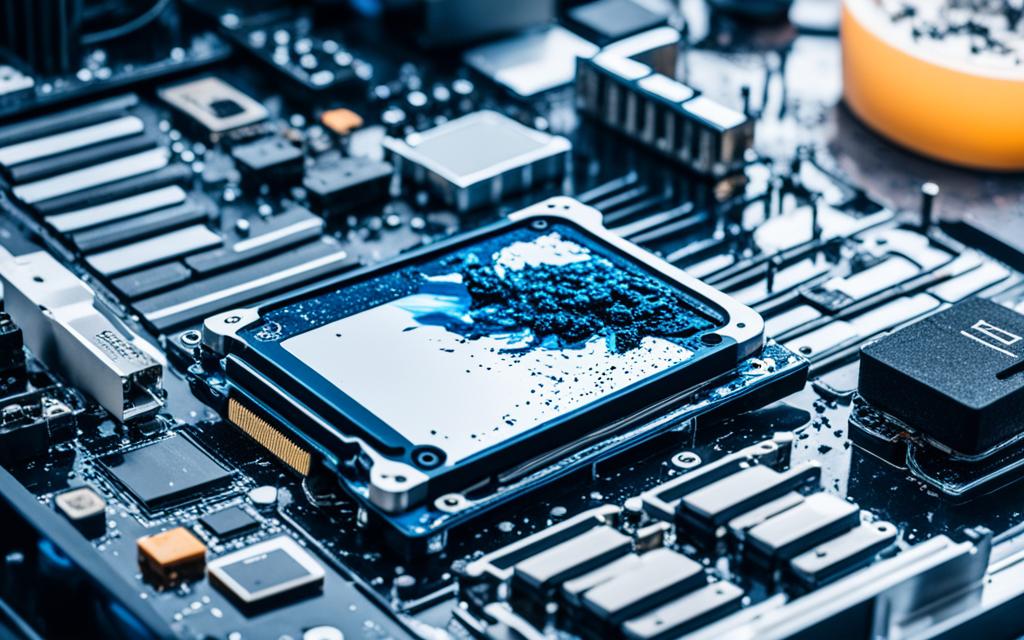Table of Contents
Solid State Drives (SSDs) are known for their speed and durability over Hard Disk Drives (HDDs). Yet, they can fail, sometimes without much warning. It’s crucial to recognize signs of potential SSD failures to protect your data. This is important as SSD failure can cause major data loss in both personal and work settings. A study by Backblaze found SSDs have an annual failure rate of 0.84% by the second year and 1.05% by the fourth year1. Most SSDs last seven to ten years, but those over five years old have a greater failure risk2. Let’s explore how to spot failing SSDs, run diagnostics, and use preventive measures to keep your data safe.
Key Takeaways
- SSDs have a limited data life known as terabytes written (TBW).
- SSD failure rates go up as they age, especially after five years.
- Use monitoring software to check on your SSD’s health.
- Keeping more than 10% of your SSD’s space free can help it last longer.
- Watch out for signs of a failing SSD like sudden crashes and slow data transfer.
- Data recovery for SSDs is usually successful, with about a 98% success rate.
Introduction to SSDs and Their Importance
SSDs have changed how we store data, offering speed and efficiency unlike old HDDs. They bring faster read and write speeds, are more durable, and use less power. This leads to quicker boot and load times, boosting performance. Given these benefits, SSDs are key in modern computers. Especially for businesses, they meet the high demand for quick data access3.
SSDs use different types of memory cells – SLCs, MLCs, and TLCs. Each has its own speed and durability level3. Besides speed, SSDs are quieter and come in smaller sizes. This versatility is seen in flash SSDs and NVMe SSDs4. Upgrading to SSDs from HDDs notably improves performance, especially in gaming PCs. Check out this guide on upgrading PC hardware for tips on enhancements.
However, SSDs have a downside – their write cycles are limited, affecting their lifespan. They typically last 7-10 years with proper care3. Power surges and overheating can shorten this life, so it’s important to be aware of failure signs. Recognising the value of SSDs encourages better data management, for a smoother computing experience5.
The Common Signs of SSD Failure
Solid-state drives (SSDs) are reliable but sometimes show signs of trouble. Spotting these SSD failure signs early is key for stopping data loss. Here are the main signs of common SSD issues.
Unexpected Crashes During Startup
If your system crashes when starting up, it might be a sign of SSD problems. This often comes from too many bad blocks. It’s a warning that your drive might fail soon. Backup your data right away6.
Slow File Saving and Transfer Times
Saving files or transferring data slowly could mean bad data blocks. SSDs slow down when they’re damaged or used too much7.
Inability to Access Certain Files
Struggling to open some files might show file system errors. These errors can happen after incorrect shutdowns, data corruption, or more bad blocks. They make the SSD less stable6.
Frequent System Restarts Required
Needing to restart often suggests the SSD isn’t working well. This can be due to hardware or software problems. That includes bad connections or old drivers7. Keeping an eye on these issues helps keep your SSD running well.
How to Diagnose if Your SSD is Failing
To effectively diagnose an SSD failure, you need software tools, knowledge of SMART errors, and manufacturer support. Using detailed SSD diagnostics is key to finding issues you might otherwise miss. We’ll now look at the important steps in this diagnostic process.
Running Diagnostic Software
Tools like CrystalDiskInfo and Hard Disk Sentinel are vital for SSD checks. They look at SMART data to show things like read/write cycles and error rates. Regular tests can spot early signs of trouble, keeping your SSD in good shape. EaseUS Partition Master makes it easy to check your SSD’s health. It finds and marks bad sectors in red during surface tests8.
Checking for SMART Errors
It’s key to regularly check for SMART errors to keep your SSD running well. SMART data gives insights on your drive’s condition, showing possible future problems. SSDs usually last five to seven years but might become read-only if these errors appear9. For Linux users, smartctl is a good way to keep track of these errors, helping keep your SSD in the best condition.
Testing Using Manufacturer’s Tools
SSD makers offer their own SSD health tools for detailed checks. These tools do thorough tests, letting you assess performance and find bad blocks. It’s vital to regularly run these tests and fixes. This helps deal with issues from things like wrong shutdowns or malware. Acting early to handle bad blocks can prevent SSD failure, keeping data safe and performance high10.
Understanding Bad Blocks and Their Impact
In the world of SSDs, knowing about bad blocks is key. These are not the same as bad sectors in hard drives. Bad blocks happen in solid-state drives because of flash memory cells wearing out from use. This wear and tear can slow down the SSD, corrupt your data, and cause many other problems.
Difference Between Bad Blocks and Bad Sectors
Bad blocks and bad sectors slow down storage devices, but they come from different places. Bad sectors are in HDDs and you can fix them. But, bad blocks in SSDs mean the memory cells are permanently damaged. This damage gets worse with more use. For example, a Samsung 970 Evo SSD went from 2 to 6 bad blocks in four years. This shows how stress affects the drive11.
Consequences of Accumulating Bad Blocks
More bad blocks mean more problems for your SSD. You’ll notice it becomes slow at reading and writing data. It might also crash unexpectedly and have trouble accessing files. This often leads to your data getting corrupted. When testing, a Kingston SSD showed a worrisome 80 bad blocks, and it couldn’t fix itself12. If these issues are ignored, your drive could eventually stop working. That’s why it’s crucial to keep an eye on your drive’s health to protect your data and keep your system running smoothly.
FAQ
What are the symptoms of SSD failure?
If your SSD is failing, you might see your computer crash when starting up. You could also notice that saving and moving files take longer. Not being able to open some files and needing to restart your system often are other signs.
How can I check the health of my SSD?
To check your SSD’s health, you can use programs like CrystalDiskInfo or Hard Disk Sentinel. These tools look at SMART data to find possible issues. This helps keep your SSD working well and your data safe.
What should I do if I suspect my SSD is failing?
Think your SSD might be failing? First, make sure to back up your data right away. Then, test your drive with SSD diagnostic tools. Using tools made by the drive’s manufacturer can spot problems early. This might mean you need to replace the drive to avoid losing files.
How do bad blocks affect SSD performance?
Bad blocks can make your SSD slow down. This means it takes longer to read and write data, and you might see errors when transferring files. As bad blocks add up, they can corrupt your data. It’s important to act quickly to save your important info.
What is the lifespan of an SSD?
SSDs usually last between seven to ten years, but it depends on how you use and look after them. Taking good care and checking it regularly can make your SSD last longer and work better.
Can SSD failure be prevented?
SSDs are generally tougher than older HDDs, but you can still reduce failure risks. Keep an eye on its health with diagnostic tools, back up files often, and protect it from power spikes. These steps can help make your SSD last.
Source Links
- https://hdsentinel.com/blog/failing-ssd-symptoms – 8 Failing SSD Symptoms and What to Do to Save Your Data
- https://www.datarecovery.net/articles/common-symptoms-of-ssd-failure.aspx – Learn about the common symptoms of SSD failure and how you can prevent it – ACE Data Recovery Article
- https://www.techtarget.com/searchstorage/definition/SSD-solid-state-drive – What is an SSD (Solid-State Drive)?
- https://www.eprovided.com/data-recovery-blog/ssd-drive-failure/ – SSD Drive Failure. What Causes Solid State Drives to Stop Working and Fail?
- https://forums.linuxmint.com/viewtopic.php?t=349753 – Is My SSD About To Fail? [SOLVED]
- https://www.techtarget.com/searchstorage/tip/4-causes-of-SSD-failure-and-how-to-deal-with-them – 7 causes of SSD failure and how to deal with them | TechTarget
- https://www.salvagedata.com/ssd-failures-common-causes-and-main-symptom/ – SSD Failures: Common Causes And Main Bad Symptoms – SalvageData
- https://www.easeus.com/partition-master/check-ssd-for-errors.html – 3 Efficient Ways to Check SSD for Errors on Windows 10/11
- https://www.thewindowsclub.com/how-to-tell-if-your-ssd-is-failing – Warning signs that tell if your SSD is failing in Windows 11/10
- https://www.neweggbusiness.com/smartbuyer/over-easy/symptoms-of-impending-ssd-hard-drive-failure-and-what-to-do/ – Symptoms of Impending SSD / Hard Drive Failure – HardBoiled
- https://www.techguy.org/threads/ssd-bad-blocks.1288898/ – Solved – SSD Bad Blocks
- https://serverfault.com/questions/484877/why-is-this-ssd-drive-failing-with-bad-sectors-and-was-it-predictable – Why is this SSD drive failing with bad sectors, and was it predictable?








